parking brake CHEVROLET KODIAK 2009 Owners Manual
[x] Cancel search | Manufacturer: CHEVROLET, Model Year: 2009, Model line: KODIAK, Model: CHEVROLET KODIAK 2009Pages: 376, PDF Size: 5.39 MB
Page 65 of 376
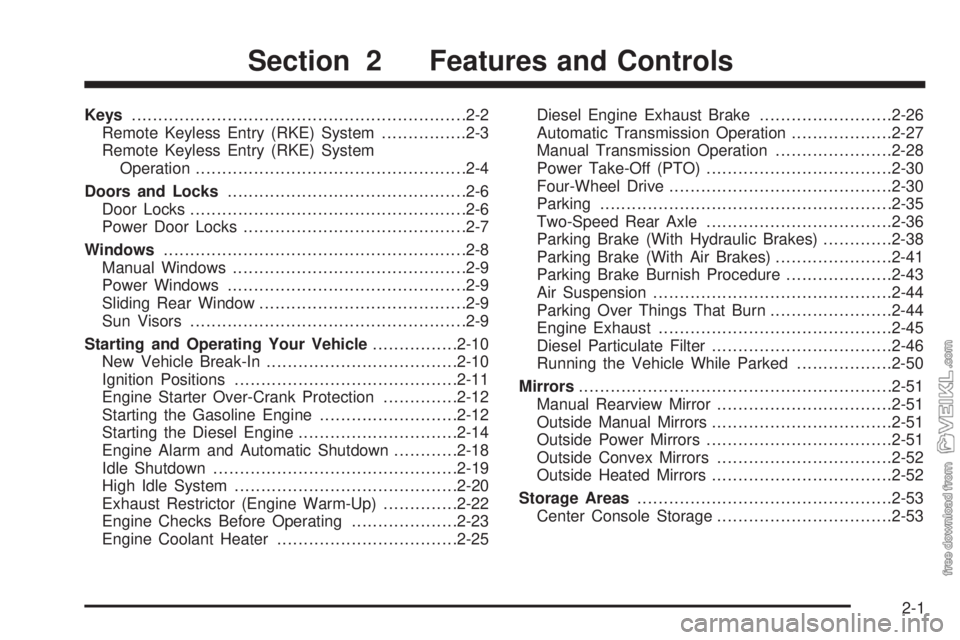
Keys...............................................................2-2
Remote Keyless Entry (RKE) System................2-3
Remote Keyless Entry (RKE) System
Operation...................................................2-4
Doors and Locks.............................................2-6
Door Locks....................................................2-6
Power Door Locks..........................................2-7
Windows.........................................................2-8
Manual Windows............................................2-9
Power Windows.............................................2-9
Sliding Rear Window.......................................2-9
Sun Visors....................................................2-9
Starting and Operating Your Vehicle................2-10
New Vehicle Break-In....................................2-10
Ignition Positions..........................................2-11
Engine Starter Over-Crank Protection..............2-12
Starting the Gasoline Engine..........................2-12
Starting the Diesel Engine..............................2-14
Engine Alarm and Automatic Shutdown............2-18
Idle Shutdown..............................................2-19
High Idle System..........................................2-20
Exhaust Restrictor (Engine Warm-Up)..............2-22
Engine Checks Before Operating....................2-23
Engine Coolant Heater..................................2-25Diesel Engine Exhaust Brake.........................2-26
Automatic Transmission Operation...................2-27
Manual Transmission Operation......................2-28
Power Take-Off (PTO)...................................2-30
Four-Wheel Drive..........................................2-30
Parking.......................................................2-35
Two-Speed Rear Axle...................................2-36
Parking Brake (With Hydraulic Brakes).............2-38
Parking Brake (With Air Brakes)......................2-41
Parking Brake Burnish Procedure....................2-43
Air Suspension
.............................................2-44
Parking Over Things That Burn.......................2-44
Engine Exhaust............................................2-45
Diesel Particulate Filter..................................2-46
Running the Vehicle While Parked..................2-50
Mirrors...........................................................2-51
Manual Rearview Mirror.................................2-51
Outside Manual Mirrors..................................2-51
Outside Power Mirrors...................................2-51
Outside Convex Mirrors.................................2-52
Outside Heated Mirrors..................................2-52
Storage Areas................................................2-53
Center Console Storage.................................2-53
Section 2 Features and Controls
2-1
Page 74 of 376
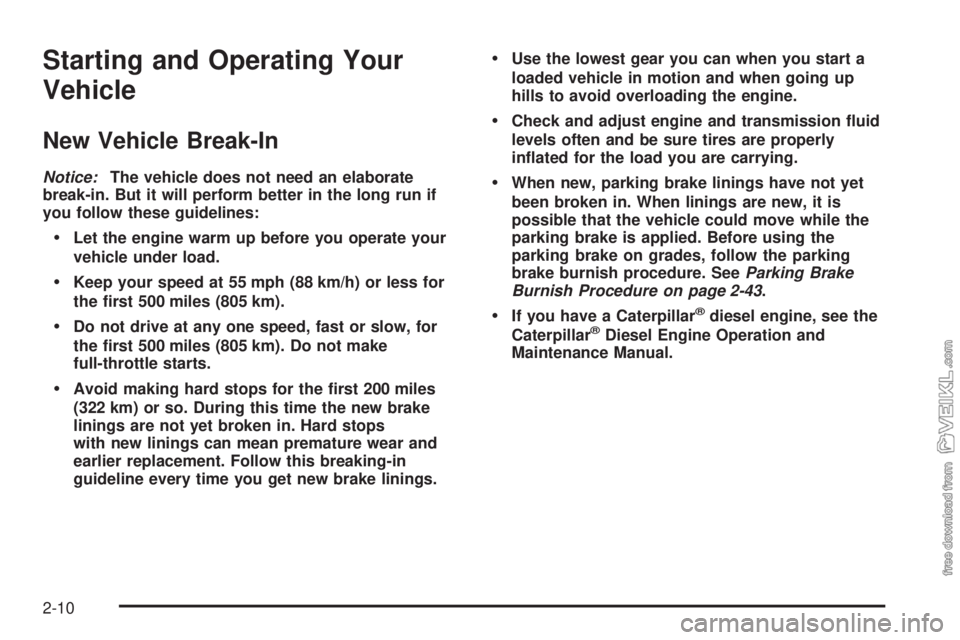
Starting and Operating Your
Vehicle
New Vehicle Break-In
Notice:The vehicle does not need an elaborate
break-in. But it will perform better in the long run if
you follow these guidelines:
•Let the engine warm up before you operate your
vehicle under load.
•Keep your speed at 55 mph (88 km/h) or less for
the first 500 miles (805 km).
•Do not drive at any one speed, fast or slow, for
the first 500 miles (805 km). Do not make
full-throttle starts.
•Avoid making hard stops for the first 200 miles
(322 km) or so. During this time the new brake
linings are not yet broken in. Hard stops
with new linings can mean premature wear and
earlier replacement. Follow this breaking-in
guideline every time you get new brake linings.
•Use the lowest gear you can when you start a
loaded vehicle in motion and when going up
hills to avoid overloading the engine.
•Check and adjust engine and transmission fluid
levels often and be sure tires are properly
inflated for the load you are carrying.
•When new, parking brake linings have not yet
been broken in. When linings are new, it is
possible that the vehicle could move while the
parking brake is applied. Before using the
parking brake on grades, follow the parking
brake burnish procedure. SeeParking Brake
Burnish Procedure on page 2-43.
•If you have a Caterpillar®diesel engine, see the
Caterpillar®Diesel Engine Operation and
Maintenance Manual.
2-10
Page 76 of 376
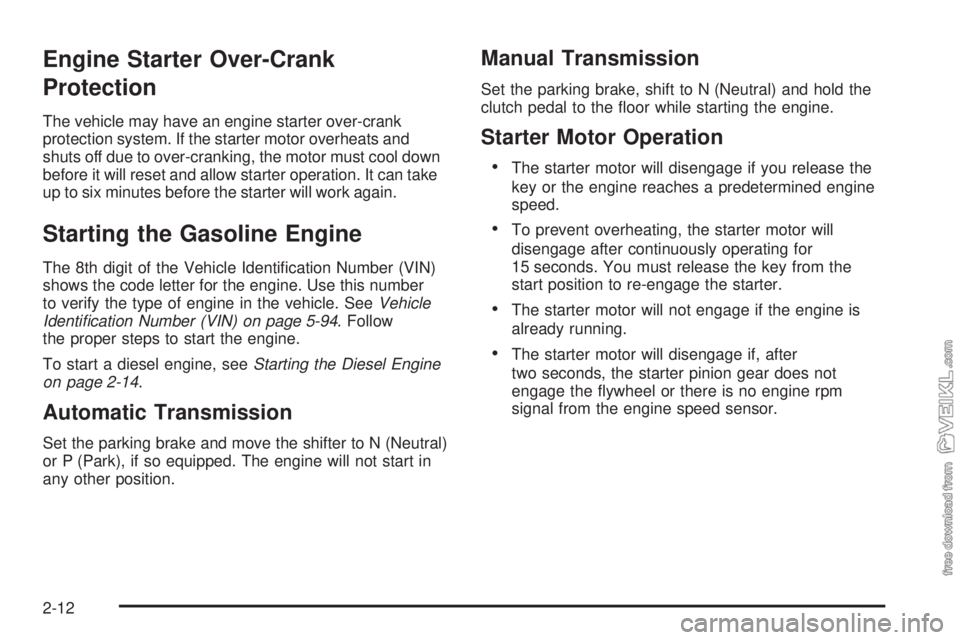
Engine Starter Over-Crank
Protection
The vehicle may have an engine starter over-crank
protection system. If the starter motor overheats and
shuts off due to over-cranking, the motor must cool down
before it will reset and allow starter operation. It can take
up to six minutes before the starter will work again.
Starting the Gasoline Engine
The 8th digit of the Vehicle Identification Number (VIN)
shows the code letter for the engine. Use this number
to verify the type of engine in the vehicle. SeeVehicle
Identification Number (VIN) on page 5-94. Follow
the proper steps to start the engine.
To start a diesel engine, seeStarting the Diesel Engine
on page 2-14.
Automatic Transmission
Set the parking brake and move the shifter to N (Neutral)
or P (Park), if so equipped. The engine will not start in
any other position.
Manual Transmission
Set the parking brake, shift to N (Neutral) and hold the
clutch pedal to the floor while starting the engine.
Starter Motor Operation
•The starter motor will disengage if you release the
key or the engine reaches a predetermined engine
speed.
•To prevent overheating, the starter motor will
disengage after continuously operating for
15 seconds. You must release the key from the
start position to re-engage the starter.
•The starter motor will not engage if the engine is
already running.
•The starter motor will disengage if, after
two seconds, the starter pinion gear does not
engage the flywheel or there is no engine rpm
signal from the engine speed sensor.
2-12
Page 77 of 376
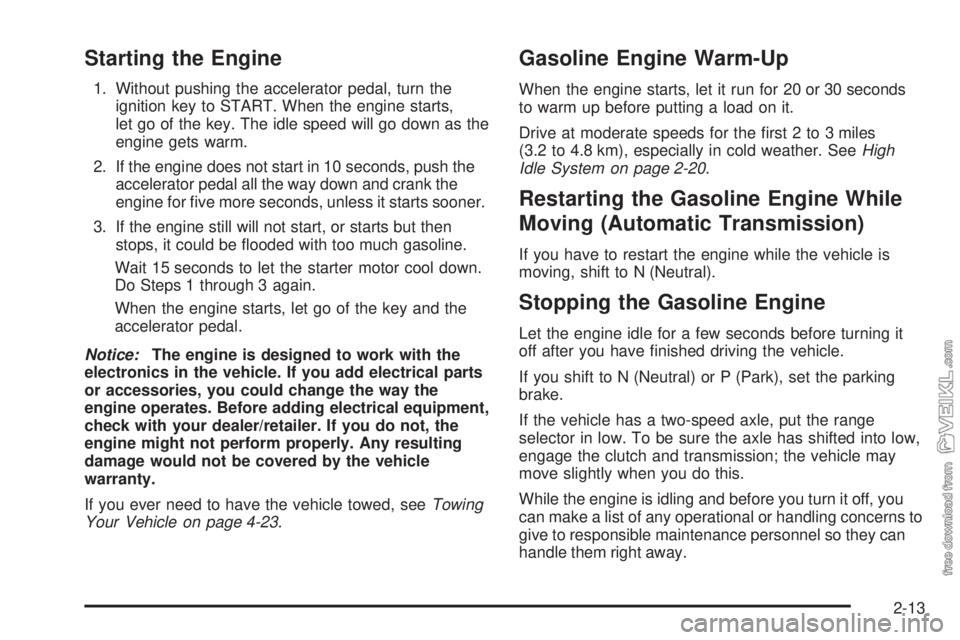
Starting the Engine
1. Without pushing the accelerator pedal, turn the
ignition key to START. When the engine starts,
let go of the key. The idle speed will go down as the
engine gets warm.
2. If the engine does not start in 10 seconds, push the
accelerator pedal all the way down and crank the
engine for five more seconds, unless it starts sooner.
3. If the engine still will not start, or starts but then
stops, it could be flooded with too much gasoline.
Wait 15 seconds to let the starter motor cool down.
Do Steps 1 through 3 again.
When the engine starts, let go of the key and the
accelerator pedal.
Notice:The engine is designed to work with the
electronics in the vehicle. If you add electrical parts
or accessories, you could change the way the
engine operates. Before adding electrical equipment,
check with your dealer/retailer. If you do not, the
engine might not perform properly. Any resulting
damage would not be covered by the vehicle
warranty.
If you ever need to have the vehicle towed, seeTowing
Your Vehicle on page 4-23.
Gasoline Engine Warm-Up
When the engine starts, let it run for 20 or 30 seconds
to warm up before putting a load on it.
Drive at moderate speeds for the first 2 to 3 miles
(3.2 to 4.8 km), especially in cold weather. SeeHigh
Idle System on page 2-20.
Restarting the Gasoline Engine While
Moving (Automatic Transmission)
If you have to restart the engine while the vehicle is
moving, shift to N (Neutral).
Stopping the Gasoline Engine
Let the engine idle for a few seconds before turning it
off after you have finished driving the vehicle.
If you shift to N (Neutral) or P (Park), set the parking
brake.
If the vehicle has a two-speed axle, put the range
selector in low. To be sure the axle has shifted into low,
engage the clutch and transmission; the vehicle may
move slightly when you do this.
While the engine is idling and before you turn it off, you
can make a list of any operational or handling concerns to
give to responsible maintenance personnel so they can
handle them right away.
2-13
Page 80 of 376
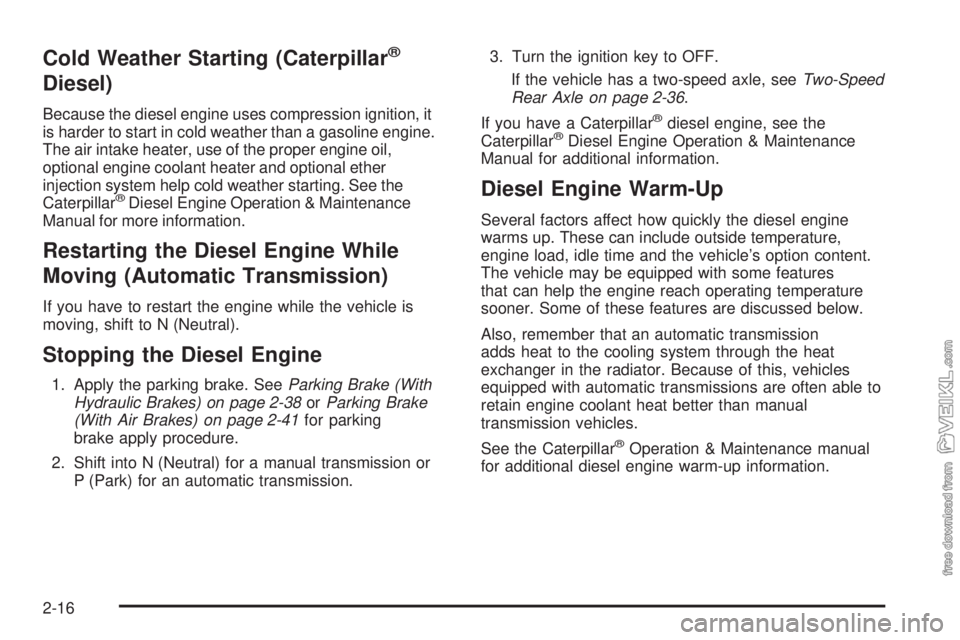
Cold Weather Starting (Caterpillar®
Diesel)
Because the diesel engine uses compression ignition, it
is harder to start in cold weather than a gasoline engine.
The air intake heater, use of the proper engine oil,
optional engine coolant heater and optional ether
injection system help cold weather starting. See the
Caterpillar
®Diesel Engine Operation & Maintenance
Manual for more information.
Restarting the Diesel Engine While
Moving (Automatic Transmission)
If you have to restart the engine while the vehicle is
moving, shift to N (Neutral).
Stopping the Diesel Engine
1. Apply the parking brake. SeeParking Brake (With
Hydraulic Brakes) on page 2-38orParking Brake
(With Air Brakes) on page 2-41for parking
brake apply procedure.
2. Shift into N (Neutral) for a manual transmission or
P (Park) for an automatic transmission.3. Turn the ignition key to OFF.
If the vehicle has a two-speed axle, seeTwo-Speed
Rear Axle on page 2-36.
If you have a Caterpillar
®diesel engine, see the
Caterpillar®Diesel Engine Operation & Maintenance
Manual for additional information.
Diesel Engine Warm-Up
Several factors affect how quickly the diesel engine
warms up. These can include outside temperature,
engine load, idle time and the vehicle’s option content.
The vehicle may be equipped with some features
that can help the engine reach operating temperature
sooner. Some of these features are discussed below.
Also, remember that an automatic transmission
adds heat to the cooling system through the heat
exchanger in the radiator. Because of this, vehicles
equipped with automatic transmissions are often able to
retain engine coolant heat better than manual
transmission vehicles.
See the Caterpillar
®Operation & Maintenance manual
for additional diesel engine warm-up information.
2-16
Page 83 of 376
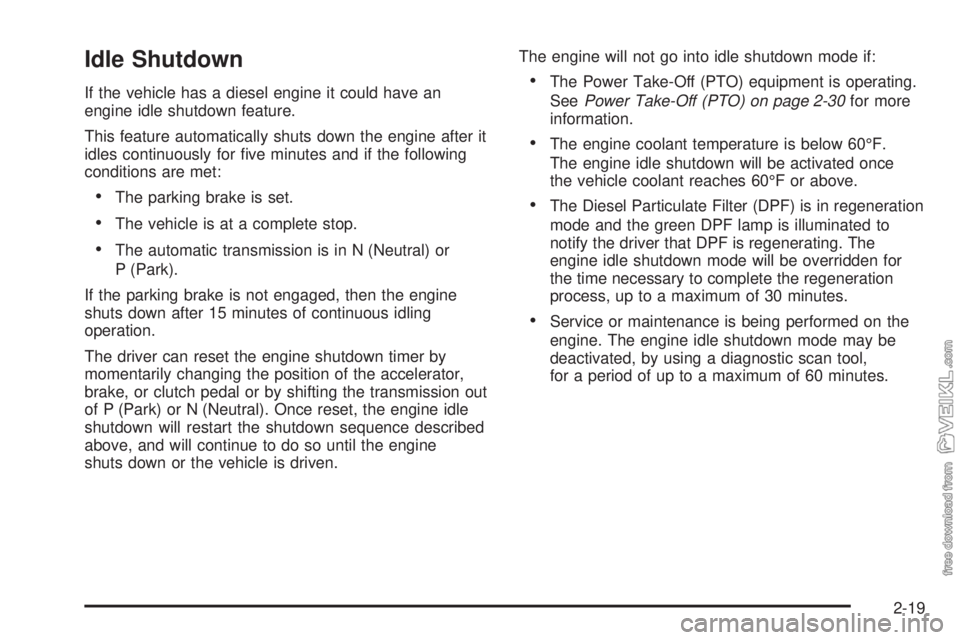
Idle Shutdown
If the vehicle has a diesel engine it could have an
engine idle shutdown feature.
This feature automatically shuts down the engine after it
idles continuously for five minutes and if the following
conditions are met:
•The parking brake is set.
•The vehicle is at a complete stop.
•The automatic transmission is in N (Neutral) or
P (Park).
If the parking brake is not engaged, then the engine
shuts down after 15 minutes of continuous idling
operation.
The driver can reset the engine shutdown timer by
momentarily changing the position of the accelerator,
brake, or clutch pedal or by shifting the transmission out
of P (Park) or N (Neutral). Once reset, the engine idle
shutdown will restart the shutdown sequence described
above, and will continue to do so until the engine
shuts down or the vehicle is driven.The engine will not go into idle shutdown mode if:
•The Power Take-Off (PTO) equipment is operating.
SeePower Take-Off (PTO) on page 2-30for more
information.
•The engine coolant temperature is below 60°F.
The engine idle shutdown will be activated once
the vehicle coolant reaches 60°F or above.
•The Diesel Particulate Filter (DPF) is in regeneration
mode and the green DPF lamp is illuminated to
notify the driver that DPF is regenerating. The
engine idle shutdown mode will be overridden for
the time necessary to complete the regeneration
process, up to a maximum of 30 minutes.
•Service or maintenance is being performed on the
engine. The engine idle shutdown mode may be
deactivated, by using a diagnostic scan tool,
for a period of up to a maximum of 60 minutes.
2-19
Page 91 of 376
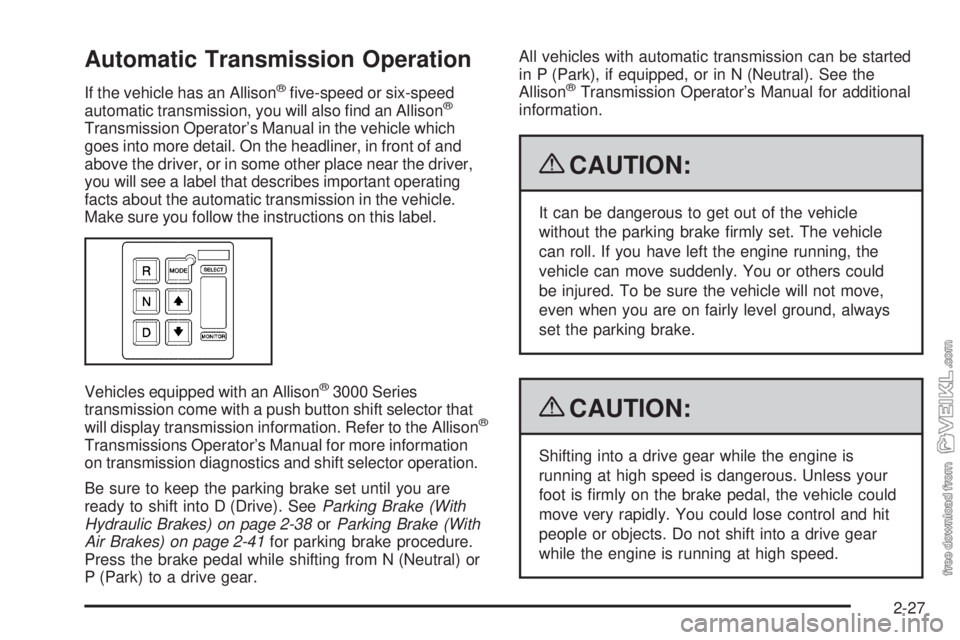
Automatic Transmission Operation
If the vehicle has an Allison®five-speed or six-speed
automatic transmission, you will also find an Allison®
Transmission Operator’s Manual in the vehicle which
goes into more detail. On the headliner, in front of and
above the driver, or in some other place near the driver,
you will see a label that describes important operating
facts about the automatic transmission in the vehicle.
Make sure you follow the instructions on this label.
Vehicles equipped with an Allison
®3000 Series
transmission come with a push button shift selector that
will display transmission information. Refer to the Allison
®
Transmissions Operator’s Manual for more information
on transmission diagnostics and shift selector operation.
Be sure to keep the parking brake set until you are
ready to shift into D (Drive). SeeParking Brake (With
Hydraulic Brakes) on page 2-38orParking Brake (With
Air Brakes) on page 2-41for parking brake procedure.
Press the brake pedal while shifting from N (Neutral) or
P (Park) to a drive gear.All vehicles with automatic transmission can be started
in P (Park), if equipped, or in N (Neutral). See the
Allison
®Transmission Operator’s Manual for additional
information.
{CAUTION:
It can be dangerous to get out of the vehicle
without the parking brake firmly set. The vehicle
can roll. If you have left the engine running, the
vehicle can move suddenly. You or others could
be injured. To be sure the vehicle will not move,
even when you are on fairly level ground, always
set the parking brake.
{CAUTION:
Shifting into a drive gear while the engine is
running at high speed is dangerous. Unless your
foot is firmly on the brake pedal, the vehicle could
move very rapidly. You could lose control and hit
people or objects. Do not shift into a drive gear
while the engine is running at high speed.
2-27
Page 96 of 376
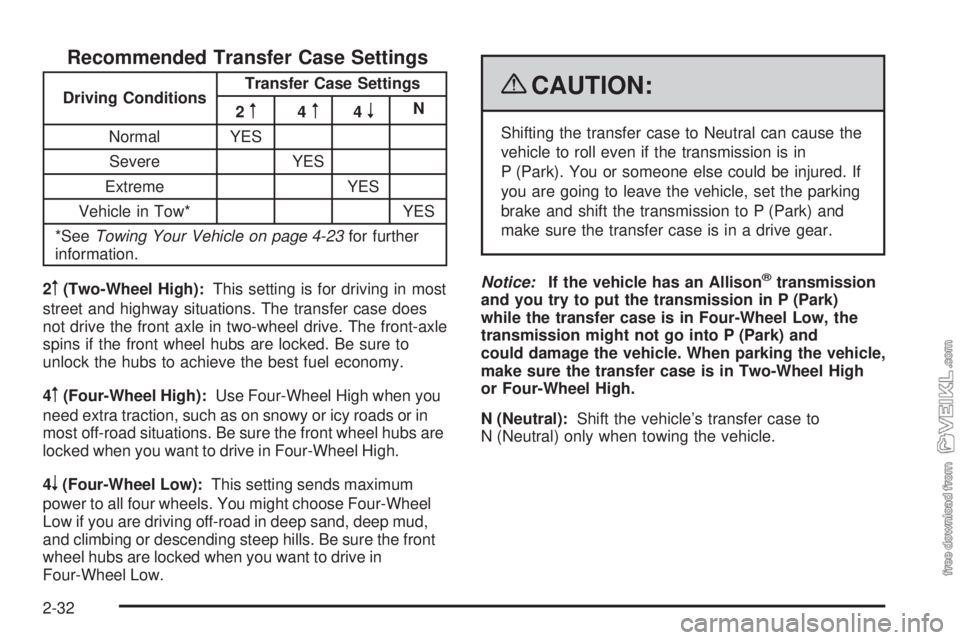
Recommended Transfer Case Settings
Driving ConditionsTransfer Case Settings
2m4m4nN
Normal YES
Severe YES
Extreme YES
Vehicle in Tow* YES
*SeeTowing Your Vehicle on page 4-23for further
information.
2
m(Two-Wheel High):This setting is for driving in most
street and highway situations. The transfer case does
not drive the front axle in two-wheel drive. The front-axle
spins if the front wheel hubs are locked. Be sure to
unlock the hubs to achieve the best fuel economy.
4
m(Four-Wheel High):Use Four-Wheel High when you
need extra traction, such as on snowy or icy roads or in
most off-road situations. Be sure the front wheel hubs are
locked when you want to drive in Four-Wheel High.
4
n(Four-Wheel Low):This setting sends maximum
power to all four wheels. You might choose Four-Wheel
Low if you are driving off-road in deep sand, deep mud,
and climbing or descending steep hills. Be sure the front
wheel hubs are locked when you want to drive in
Four-Wheel Low.
{CAUTION:
Shifting the transfer case to Neutral can cause the
vehicle to roll even if the transmission is in
P (Park). You or someone else could be injured. If
you are going to leave the vehicle, set the parking
brake and shift the transmission to P (Park) and
make sure the transfer case is in a drive gear.
Notice:If the vehicle has an Allison
®transmission
and you try to put the transmission in P (Park)
while the transfer case is in Four-Wheel Low, the
transmission might not go into P (Park) and
could damage the vehicle. When parking the vehicle,
make sure the transfer case is in Two-Wheel High
or Four-Wheel High.
N (Neutral):Shift the vehicle’s transfer case to
N (Neutral) only when towing the vehicle.
2-32
Page 98 of 376
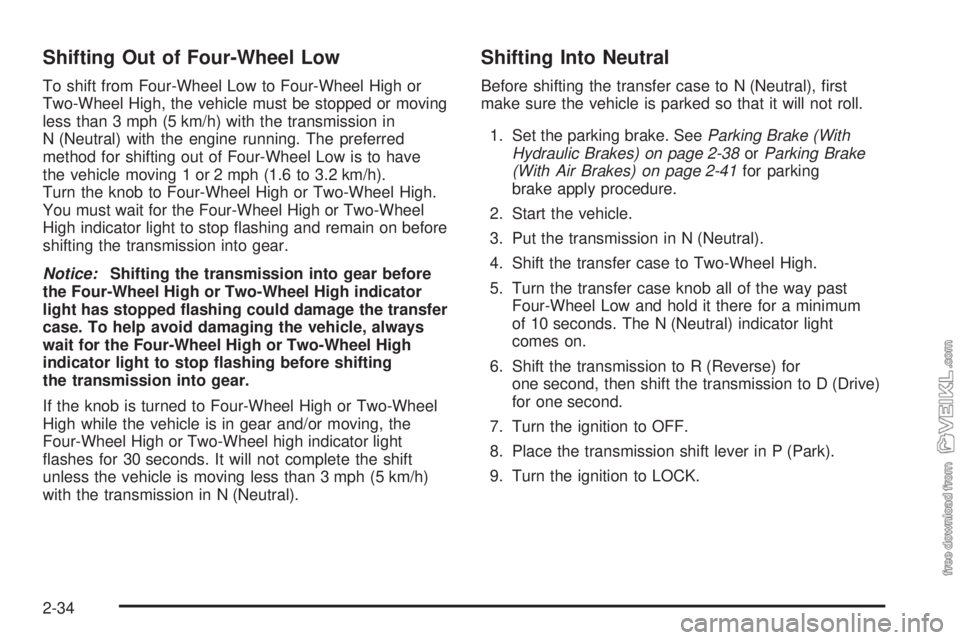
Shifting Out of Four-Wheel Low
To shift from Four-Wheel Low to Four-Wheel High or
Two-Wheel High, the vehicle must be stopped or moving
less than 3 mph (5 km/h) with the transmission in
N (Neutral) with the engine running. The preferred
method for shifting out of Four-Wheel Low is to have
the vehicle moving 1 or 2 mph (1.6 to 3.2 km/h).
Turn the knob to Four-Wheel High or Two-Wheel High.
You must wait for the Four-Wheel High or Two-Wheel
High indicator light to stop flashing and remain on before
shifting the transmission into gear.
Notice:Shifting the transmission into gear before
the Four-Wheel High or Two-Wheel High indicator
light has stopped flashing could damage the transfer
case. To help avoid damaging the vehicle, always
wait for the Four-Wheel High or Two-Wheel High
indicator light to stop flashing before shifting
the transmission into gear.
If the knob is turned to Four-Wheel High or Two-Wheel
High while the vehicle is in gear and/or moving, the
Four-Wheel High or Two-Wheel high indicator light
flashes for 30 seconds. It will not complete the shift
unless the vehicle is moving less than 3 mph (5 km/h)
with the transmission in N (Neutral).
Shifting Into Neutral
Before shifting the transfer case to N (Neutral), first
make sure the vehicle is parked so that it will not roll.
1. Set the parking brake. SeeParking Brake (With
Hydraulic Brakes) on page 2-38orParking Brake
(With Air Brakes) on page 2-41for parking
brake apply procedure.
2. Start the vehicle.
3. Put the transmission in N (Neutral).
4. Shift the transfer case to Two-Wheel High.
5. Turn the transfer case knob all of the way past
Four-Wheel Low and hold it there for a minimum
of 10 seconds. The N (Neutral) indicator light
comes on.
6. Shift the transmission to R (Reverse) for
one second, then shift the transmission to D (Drive)
for one second.
7. Turn the ignition to OFF.
8. Place the transmission shift lever in P (Park).
9. Turn the ignition to LOCK.
2-34
Page 99 of 376
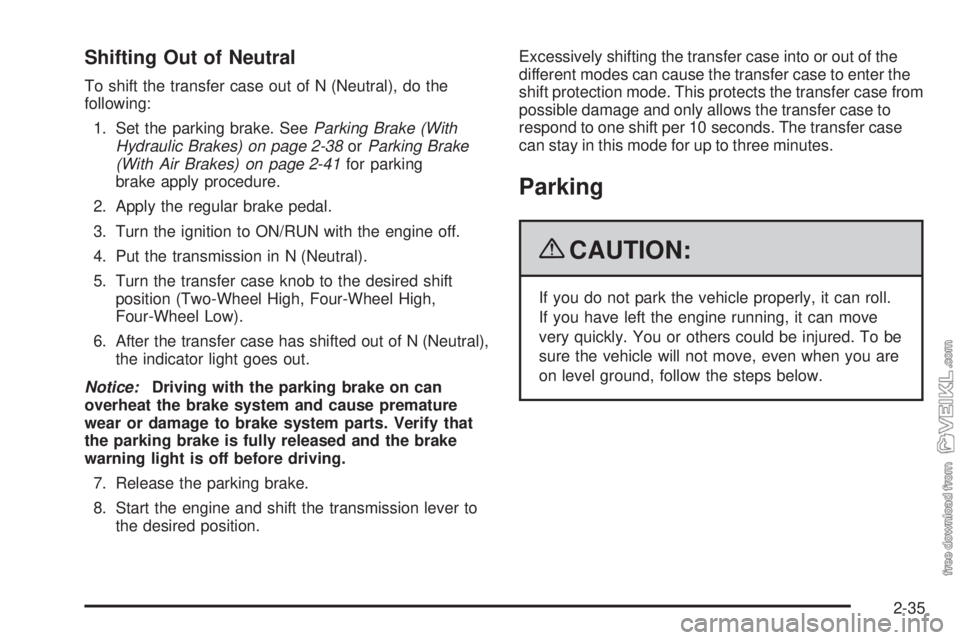
Shifting Out of Neutral
To shift the transfer case out of N (Neutral), do the
following:
1. Set the parking brake. SeeParking Brake (With
Hydraulic Brakes) on page 2-38orParking Brake
(With Air Brakes) on page 2-41for parking
brake apply procedure.
2. Apply the regular brake pedal.
3. Turn the ignition to ON/RUN with the engine off.
4. Put the transmission in N (Neutral).
5. Turn the transfer case knob to the desired shift
position (Two-Wheel High, Four-Wheel High,
Four-Wheel Low).
6. After the transfer case has shifted out of N (Neutral),
the indicator light goes out.
Notice:Driving with the parking brake on can
overheat the brake system and cause premature
wear or damage to brake system parts. Verify that
the parking brake is fully released and the brake
warning light is off before driving.
7. Release the parking brake.
8. Start the engine and shift the transmission lever to
the desired position.Excessively shifting the transfer case into or out of the
different modes can cause the transfer case to enter the
shift protection mode. This protects the transfer case from
possible damage and only allows the transfer case to
respond to one shift per 10 seconds. The transfer case
can stay in this mode for up to three minutes.
Parking
{CAUTION:
If you do not park the vehicle properly, it can roll.
If you have left the engine running, it can move
very quickly. You or others could be injured. To be
sure the vehicle will not move, even when you are
on level ground, follow the steps below.
2-35